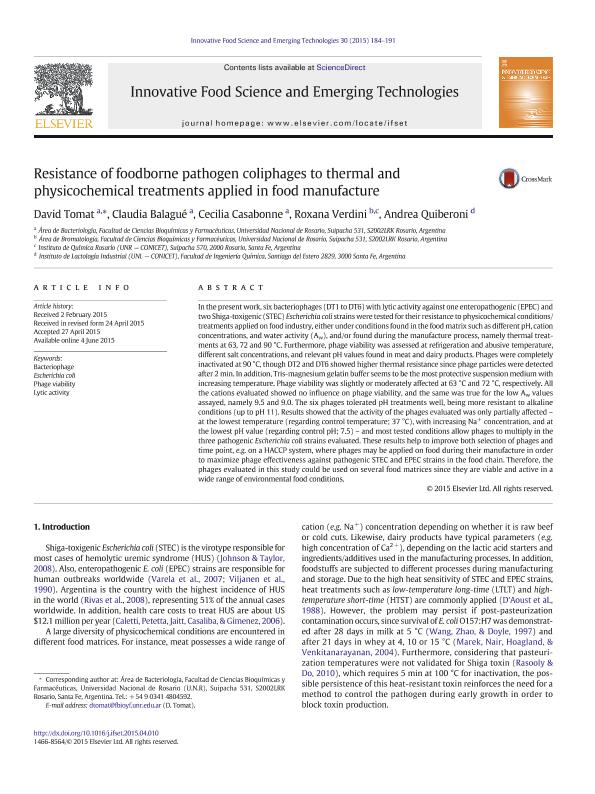Mostrar el registro sencillo del ítem
dc.contributor.author
Tomat, David Damian

dc.contributor.author
Balague, Claudia Elisabeht

dc.contributor.author
Casabonne, Cecilia
dc.contributor.author
Verdini, Roxana Andrea

dc.contributor.author
Quiberoni, Andrea del Lujan

dc.date.available
2018-06-29T17:05:33Z
dc.date.issued
2015-05
dc.identifier.citation
Tomat, David Damian; Balague, Claudia Elisabeht; Casabonne, Cecilia; Verdini, Roxana Andrea; Quiberoni, Andrea del Lujan; Resistance of foodborne pathogen coliphages to thermal and physicochemical treatments applied in food manufacture; Elsevier; Innovative Food Science & Emerging Technologies; 30; 5-2015; 184-191
dc.identifier.issn
1466-8564
dc.identifier.uri
http://hdl.handle.net/11336/50664
dc.description.abstract
In the present work, six bacteriophages (DT1 to DT6) with lytic activity against one enteropathogenic (EPEC) and two Shiga-toxigenic (STEC) Escherichia coli strains were tested for their resistance to physicochemical conditions/treatments applied on food industry, either under conditions found in the food matrix such as different pH, cation concentrations, and water activity (Aw), and/or found during the manufacture process, namely thermal treatments at 63, 72 and 90 °C. Furthermore, phage viability was assessed at refrigeration and abusive temperature, different salt concentrations, and relevant pH values found in meat and dairy products. Phages were completely inactivated at 90 °C, though DT2 and DT6 showed higher thermal resistance since phage particles were detected after 2 min. In addition, Tris-magnesium gelatin buffer seems to be the most protective suspension medium with increasing temperature. Phage viability was slightly or moderately affected at 63 °C and 72 °C, respectively. All the cations evaluated showed no influence on phage viability, and the same was true for the low Aw values assayed, namely 9.5 and 9.0. The six phages tolerated pH treatments well, being more resistant to alkaline conditions (up to pH 11). Results showed that the activity of the phages evaluated was only partially affected - at the lowest temperature (regarding control temperature; 37 °C), with increasing Na+ concentration, and at the lowest pH value (regarding control pH; 7.5) - and most tested conditions allow phages to multiply in the three pathogenic Escherichia coli strains evaluated. These results help to improve both selection of phages and time point, e.g. on a HACCP system, where phages may be applied on food during their manufacture in order to maximize phage effectiveness against pathogenic STEC and EPEC strains in the food chain. Therefore, the phages evaluated in this study could be used on several food matrices since they are viable and active in a wide range of environmental food conditions.
dc.format
application/pdf
dc.language.iso
eng
dc.publisher
Elsevier

dc.rights
info:eu-repo/semantics/openAccess
dc.rights.uri
https://creativecommons.org/licenses/by-nc-nd/2.5/ar/
dc.subject
Bacteriophage
dc.subject
Escherichia Coli
dc.subject
Lytic Activity
dc.subject
Phage Viability
dc.subject.classification
Otras Ciencias Biológicas

dc.subject.classification
Ciencias Biológicas

dc.subject.classification
CIENCIAS NATURALES Y EXACTAS

dc.title
Resistance of foodborne pathogen coliphages to thermal and physicochemical treatments applied in food manufacture
dc.type
info:eu-repo/semantics/article
dc.type
info:ar-repo/semantics/artículo
dc.type
info:eu-repo/semantics/publishedVersion
dc.date.updated
2018-06-29T12:57:01Z
dc.journal.volume
30
dc.journal.pagination
184-191
dc.journal.pais
Países Bajos

dc.journal.ciudad
Amsterdam
dc.description.fil
Fil: Tomat, David Damian. Universidad Nacional de Rosario. Facultad de Ciencias Bioquímicas y Farmacéuticas; Argentina. Consejo Nacional de Investigaciones Científicas y Técnicas; Argentina
dc.description.fil
Fil: Balague, Claudia Elisabeht. Universidad Nacional de Rosario. Facultad de Ciencias Bioquímicas y Farmacéuticas; Argentina
dc.description.fil
Fil: Casabonne, Cecilia. Universidad Nacional de Rosario. Facultad de Ciencias Bioquímicas y Farmacéuticas; Argentina
dc.description.fil
Fil: Verdini, Roxana Andrea. Universidad Nacional de Rosario. Facultad de Ciencias Bioquímicas y Farmacéuticas; Argentina. Consejo Nacional de Investigaciones Científicas y Técnicas. Centro Científico Tecnológico Conicet - Rosario. Instituto de Química Rosario. Universidad Nacional de Rosario. Facultad de Ciencias Bioquímicas y Farmacéuticas. Instituto de Química Rosario; Argentina
dc.description.fil
Fil: Quiberoni, Andrea del Lujan. Consejo Nacional de Investigaciones Científicas y Técnicas. Centro Científico Tecnológico Conicet - Santa Fe. Instituto de Lactología Industrial. Universidad Nacional del Litoral. Facultad de Ingeniería Química. Instituto de Lactología Industrial; Argentina
dc.journal.title
Innovative Food Science & Emerging Technologies

dc.relation.alternativeid
info:eu-repo/semantics/altIdentifier/doi/http://dx.doi.org/10.1016/j.ifset.2015.04.010
dc.relation.alternativeid
info:eu-repo/semantics/altIdentifier/url/https://www.sciencedirect.com/science/article/pii/S1466856415000971
Archivos asociados
